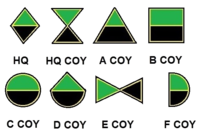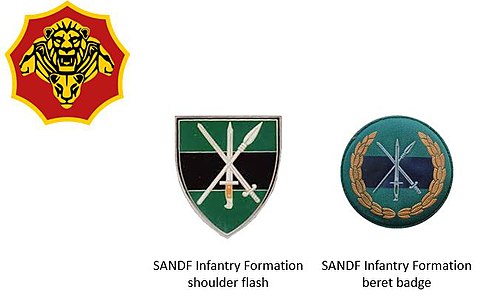History
Colony Frontier
The regiment was formed from the First City Volunteers (FCV) of Grahamstown that were formed in 1875 in Grahamstown [2] : 540 and the Queenstown Rifle Volunteers (QVR) that were formed in 1860 (Re-raised 1883) in Queenstown and these regiments were formed due to the unrest on the then frontier.
The QVR and the FCV fought in the Cape Frontier Wars and the 9th Frontier War (1877–1878). [2] : 540 The QVR fought in the Morosi Campaign (1879). The FCV fought in the Basutoland Gun War (1880–1881). [2] : 540 The QVR and the FCV later fought in the Bechuanaland campaign (1897), and in the Second Boer War (1899–1902). [2] : 540 [3]
Union Defence Force
On 1 July 1913, the QVR amalgamated with the FCV and was incorporated into the Citizen Force of the new Union Defence Force as the 4th Infantry (First Eastern Rifles). [2] : 540 It served in German South-West Africa 1914–1915. [2] : 540 [3]
However, in 1924 the First Eastern Rifles were renamed the 4th Infantry (First City). [2] : 540 The numerical part of the title was dropped in 1932, making the regiment simply First City. [2] : 540
In the mid-1930s, the regiment adopted Scottish uniform, including the Graham of Montrose tartan.
World War II
During World War II, FC served in the Madagascar campaign (1942). [2] : 540 On 5 October 1943, First City, South Africa's senior Scottish unit, was temporarily "married up" with the Cape Town Highlanders to form the FC/CTH which was part of the 12th South African Motorised Brigade of the South African 6th Armoured Division. [2] : 540 The "marriage" lasted until 8 May 1945. After completing its training in Egypt, the division landed at Taranto, Italy on 20 April 1944 and fought exclusively in Italy during its existence. [2] : 540 [4] In 1946, the regiment was reconstituted as a component of the country's part-time forces and reformed First City. [3]
From 1954 to 1956, FC was amalgamated with the Kaffrarian Rifles, known as First City/Kaffrarian Rifles. In 1956 it reverted to being called First City.
Post 1994
In 2004 it was decided to rebuild First City and by 2006 the regiment was training its own members as well as members of the Prince Alfred's Guard, The Buffalo Volunteer Rifles and Regiment Piet Retief these all being Eastern Cape regiments. Many members have also been trained in Air Assault. The Regiment has also sent members on UN & AU peace keeping missions to the DRC, Burundi and the Sudan.
2008 saw First City winning the trophy for the best reserve force regiment in the SA Army Infantry Formation. The regiment retained this award for 2009. [1]
Name change
In August 2019, 52 Reserve Force units had their names changed to reflect the diverse military history of South Africa. [5] The First City became the Chief Makhanda Regiment, and have 3 years to design and implement new regimental insignia. [6]
This page is based on this
Wikipedia article Text is available under the
CC BY-SA 4.0 license; additional terms may apply.
Images, videos and audio are available under their respective licenses.





